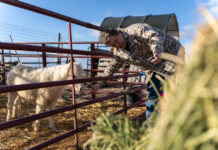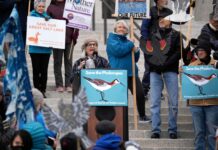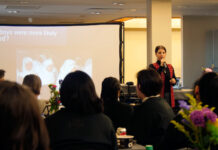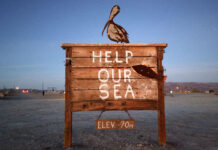The Great Salt Lake Collaborative is a group of news, education and media organizations – including The Globe, Amplify Utah and student journalists at Salt Lake Community College – that have come together to better inform and engage the public about the crisis facing the Great Salt Lake.
The following story was originally published in KSL.com, a collaborative partner.

“How worried should we be?”
“If people see that there’s less water, why keep taking it?”
“Will it get worse?”
These were some of the questions high schoolers from Horizonte Instruction and Training Center asked during a trip to Antelope Island on Thursday, Oct 27. The trip is part of a hands-on approach to teaching students about the Great Salt Lake and its impact on them and their communities.
Junior Nayeli Lazareno said learning about the toxic dust from the drying lakebed was concerning.
“It’s scary, super scary. It’s going to make our air pollution very bad,” she said. “I didn’t know how bad it was. Coming here, it shows you a different perspective of everything.”
Stavros Pretorius, a senior at Horizonte, grew up coming to the lake and has watched the water levels slowly taper off. He’s taken a keen interest in the lake’s health.
“Because it doesn’t just affect our health; it also affects our general livelihood. When you look at the billions of dollars that are generated from lake water, it becomes apparent that it’s also an economic crisis, not just a health crisis,” Pretorius said.
“The first thing I would recommend is for young people to start emailing the Utah Division of Water,” he added, referring to a recent controversy over whether companies should continue to be allowed to siphon lake water. “We should be telling these regulatory bodies that they need to do their jobs and regulate our health and our economy and the lake.”
Lazareno and Pretorius were among about 100 students who made the trek out to Antelope Island Thursday. Teachers said interest in the trip was overwhelming. In fact, another 20 students had to stay behind since the school had only two of the three buses it requested.
Horizonte, an alternative public school in Salt Lake City, serves students who do best in nontraditional learning environments and smaller classrooms, said principal Tracy Sjostrom. She added that many have experienced a great deal of trauma and have credit deficiencies and past attendance issues.
“We’re really trying to have engaging activities so that they want to come to school, to really build their curiosity and their passion for learning,” Sjostrom said. “A lot of our kids never get into nature; they’re just in the inner city. And we’re in such a beautiful spot, but rarely do they get in the mountains or get out to Antelope Island. So I see a lot of joy here and I’m so excited to see all the kids wanting to come here.”
Julius Ramirez, a West Valley City senior, said the trip was his first visit to the lake. “I really enjoyed the experience,” he said. “My favorite part is probably just the history and the nature.”

Horizonte teachers are using the trip as a springboard to explore the lake through their respective subjects. A language arts teacher, for example, is devoting a term to literature about the lake; while a science teacher is looking at the lake’s geology.
Geography and history teacher Marisa Wilson is digging into legislative proposals to save the lake with her students.
“It’s going to culminate with the opportunity to take action — and that piece, in particular, is new to a lot of my students who are feeling empowered to write their state representative, or feel like they can have a voice in the conversation,” she said.
Nisie Antacle, who teaches math and environmental science, is focusing on the question, “How does the health of the Great Salt Lake affect my health?” with her students. She plans on working with students to write editorials or create public service announcements that they can post on social media.
“I wanted to make it relevant,” Antacle said. “For them to feel that they can be a part of the solution and really make awareness of the ongoing crisis that our lake is in. So we’re just hoping that this trip will really impact their lives in a way that will inspire them to help inform others and hopefully to protect their own health and give them ways to change actions, either on a higher level or even just in their own communities.”
Outside the classroom, many of the school’s students are experiencing firsthand the uneven toll that poor air quality has on minority and low-income neighborhoods. Over 80% of the school’s students are children of color, and most live in Rose Park, North Salt Lake or Glendale. Those neighborhoods, along with the rest of the west side, are in closer proximity to the lake and suffer from worse air quality than their east side counterparts.
University of Utah professor Kevin Perry said the toxic dust from the drying lakebed will compound the already disproportionate air pollution on the west side.
“A lot of people refer to it as social justice. I call it social injustice in terms of the people that are being exposed to poor air quality,” Perry said. “We know that the western side of Salt Lake County has worse air quality than the eastern side … but the dust that’s coming off from from the lake will also affect the people that live closest to the lake and the people along the west side as well. So it’s just one more type of air pollution that the people that live in those areas will be subjected to if we don’t do something to mitigate the dust.”
Factors like the historic impact of discriminatory housing policies and socioeconomic inequities concerning race and ethnicity also contribute to who is most impacted by respiratory issues. Asthma, for example, disproportionately burdens Black, Hispanic and American Indian Americans, according to the Asthma and Allergy Foundation of America.
Antacle, the math and environmental science teacher, said many of her students have asthma or know a family or friend with respiratory issues.
“I think they’re starting to think about, ‘Wow, this will be something in my future that I’m gonna have to think about,'” she said. “I think this (trip) will really drive it home a little bit more. I think they’ll realize there is a crisis going on.”







